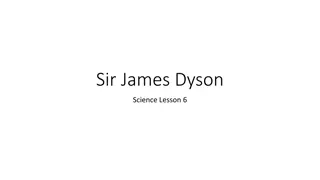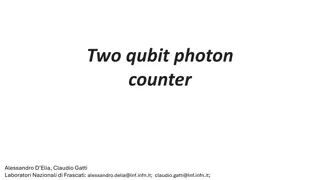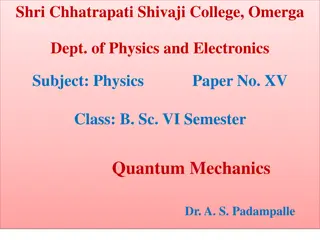Green's Functions and Dyson Expansion in Quantum Theory
The significance of Green's functions, Dyson equations, Feynman diagrams, and more in quantum theory. Understand the relation to solutions of differential equations, electron density of states, and perturbation theory.
Download Presentation

Please find below an Image/Link to download the presentation.
The content on the website is provided AS IS for your information and personal use only. It may not be sold, licensed, or shared on other websites without obtaining consent from the author.If you encounter any issues during the download, it is possible that the publisher has removed the file from their server.
You are allowed to download the files provided on this website for personal or commercial use, subject to the condition that they are used lawfully. All files are the property of their respective owners.
The content on the website is provided AS IS for your information and personal use only. It may not be sold, licensed, or shared on other websites without obtaining consent from the author.
E N D
Presentation Transcript
Week 5, Green s functions, Dyson expansion Contour ordered Green s function, Wick s theorem, Feynman diagrams, Dyson equations, analytic continuation , Keldysh equation
Why Greens functions? Solutions to differential equations Retarded Green s function is related to the linear response theory Im ??gives electron density of states Related to (nonequilibrium) physical observables such as the electron or energy current 2
Perturbation theory, single electron = h V + H = + 1 1 1 1 use ( ) A B B B A A ( ) ( ) 1 1 = = = = = + i r r Let , , G A z H g B z h z E + then G g g VG = + 0 r r r r The last equation is known as Dyson equation or Lippmann-Schwinger 3
Interaction picture 1) Schr dinger picture: wave function changes with time according to t ( / ) i ( '') '' H t dt = = ( ) t ( , ') ( '), O ( , ') U t t , ' U t t t Te t t ' t Operator has no dynamics. : time ordering T Heisenberg picture: O [ , i O H t dt perators satisfy , t 2) dO O = + ( )] = = while wave function is fixed, say at 0, ( ). t t 0 0 H = + Interaction picture, '( ), operator follows H t H H 3) 0 d Oe = = / / iH t iH t ( ) , and state follows : ' ( ) I , O t e i H t I 0 0 I I dt H t e = = / / / iH t iH t iH t where ( ) t ( ), and t ' ( ) I '( ) e H t e 0 0 0 I
Expectation values B = = = Tr( ) Tr( ) Tr( ) O O O O A t 0+ H H I I t 0 correlation function ( '): t t = = ( ) ( ') A t B t ( ) ( ') t (0, ) ( , ') ( ',0) A t B U t AU t t BU t H H / / / / '/ '/ '/ '/ iH t iH t iH t iH t iH t iH t iH t iH t = (0, ) ( , ') U t t e ( ',0) U t U t e e Ae e e Be e 0 0 0 0 0 0 0 0 1 / / '/ '/ iH t iH t iH t iH t = (0, ) ( ) ( , ') U t t e ( ') ( ',0) U t U t e A t e B t e 0 0 0 0 I I ' ( ) I ( / ) i H d + = = (0 , ) ( ) ( , ') t A t S t t B t S t ( ') ( ',0 ) ( ) ( ') S T A t B t e I I I I ( , ') S t t t = = / 0'/ iH t iH t ( , ') S t t ( , ') , ' ( ) ( , ') I t S t t e U t t e i H 0
Adiabatic switch-on of interaction = = = Tr (0) , (0) (0) I H d d dt = [ , = t ] in interaction picture [ , ' ( ) I ] i H i H t e I I dt + 0 , t 0 t ( / ) i ' ( ') I ' H t dt = = = ( ) t ( , ) S t t ( ) ( , ), t S t t ( , ) S t t , ) ( , ) 1 S t t S t t ( Te t 0 0 0 0 0 0, 0 I I ( ) ( / ) i ' H d = ( ) ( ') A t B t ( ) ( ') T A t B t e Tr ( I I I I = ) ( S ,0) (0, ) S ( ) ( , ') t A t S t t B t S t ( ') ( ',0) (0, ) S I I ' ( '') I ( / ) i '' H d = Tr ( ) ( ) ( ') T A t B t e I I I ( ) H N ( ) e 0 I
Contour ordered Greens function - , + I + ( ) - , ( ) ( ') /( ) if ( ') ( ) /( ) if ' B A ' ( ' proceeds on contour) , ( bosonic, + A B i i 1 i ( , ') = ( ) ( ') T A = G B AB fermionic) 1 i ( / ) i ' ( ' I ') '' H d ( ) ( ') = Tr ( ) T A B e I I I = Tr ( ) I H 0 = = k For electron, we take , . A c B c j
Dyson expansion 2 3 1 i 1 2! 1 i 1 3! 1 i ' ( '') I ( / ) i '' H d = + ' ( '') I + ' ( ) I ' ( ) I + 1 '' e H d H d H d d d d 1 1 2 2 1 2 3 1 i ' ( '') I ( / ) i '' H d ( , ') = ( ) ( ') Tr ( ) G T A B e AB I I I 2 1 i 1 i 1 2! 1 i = ( ) ( ') 1 + ( '') + ' ( ) I ' ( ) I + ' '' T A B H d H d H d 1 1 2 2 I I I H 0 2 1 i = ( , ') + ( ) ( ') ' ( '') I + 0 AB '' G T A B H d I I H 0 3 1 2! 1 i ( ) ( ') ' ( ) I ' ( ) I + T A B H d H d 1 1 2 2 I I H 0
Contour order operator T 1 n ( ) ( ) ( ) T H d H d H d 1 1 2 2 n n ! ' ' ' ( ) 1 n = ( ) ( ) ( ) d d d T H H H 1 2 1 2 n n ! ' ' ' 1 n 1 = ( ) ( ) ( ) H d H d H d 1 1 2 2 n n ' ' ' ' 1 2 1 n n
Wicks theorem ( ) ( ) ( ) T A B = ( ) ( ) ( ) T A C , C B 1 2 3 1 3 2 2 2 = (1) (2) (3) a ( ) ( ) T a i a i ( ) ( ) T a i a i T a a 1 2 3 4 all possible/distinct pairing = ( , ) [space and contour time label] i i j ( ) i Bosonic (phonon) example: (1) (2) (3) (4 T u u u = + + ) (1) (2) u (3) (4) u (1) (3) u (2) (4) u u T u T u T u T u (1) (4) u (2) (3) u T u T u + = H Here Tr , and must be a noninteraction quadratic form. e H 0 0
Wicks theorem as a determinant for fermions 1' 2' n' (1, g 1 2 (1,1') (2,1') (1,2') (2,2') ') g g g g n 1 = (1) (2) (3) c ( ) ( ') c n c n (2') (1') c det T c c c ( ) i n ( ,1') g n ( , ') g n n n 1 i = = ( , ) i l = ( , ') g i j ( ) ( ') , T c i c ( ) i ( -th position variable, -th contour time) i j i i
Derivation of the Dyson equation (electron case) = g G + G g or ( , ') = ( , ') + ( , ) ( , ( , ') ) G g d d g G 1 2 1 1 2 2 jk jk jl lm mk lm Derive this equation using the Hamiltonian ? = ? ?? +1 to first order in the interaction term, show that the self energy is given on the next slide. ?? ???? 2 ?????
Hartree and Fock self energies g v 1 for each loop k l m g v ( , + ( , = 2 F lm ) ( , ) ) i e v g 1 2 1 2 1 1 lm lm l ( , + ( , = 2 H lm ) ( , ) ) i e v g = + HF H F 1 2 1 2 lm lk kk k
Calculus on the contour Integration on (Keldysh) contour + = + + + ( ) = ( ) t ( ) t dt ( ) t dt f d f dt f f = Differentiation on contour ( ) d ( ) t df df dt 14
Theta function and delta function ( , ') 1 if is later than ' along the contour 0 otherwise = Theta function ++ = = = = ( , ') ( , ') ( , ') ( , ') 1 t t ( ( ' t ') ) t t t t t t t t t = ( , t ) ( , ') = ' ( , ') t t + 0 + Delta function on contour ( , ') d d ( , ') = = ' ' ( , ') t t ( ') t t where (t) and (t) are the ordinary Heaviside theta and Dirac delta functions 15
The Langreth theorem + ( , ') = ( , '') ( '', ') A B '' '' ' '' ( , '') t t B ( '', ') '' t t '' C d A dt '' = = r r r r r r ( , ') ( , '') A t t B t t dt ( '', ') '' ( ) ( ) ( ) C t t C E A E B E = + r a ( , ') ( , '') A t t B t t dt ( '', ') '' ( , '') ( '', ') '' C t t A t t B t t dt = + r a ( ) E ( ) ( ) ( ) E B E ( ) C A E B E A ( , ') = ( , ) ( , A ) ( , ') C d d D B 1 1 2 2 1 2 = = r r r r , D D A B C A B C + + r r r a a a A B C A B C 16
Transformation/Keldysh Rotation ( , ') jj A A ' ( , ') t t A ' ' jj t A A A A = ' ' or A A A t 1 0 0 1 1 1 = = = T , , R RR I z 1 1 1 2 r K A A A A + = = = T T A R AR R AR z K a + + + + + t t t t A A A A A A A A A A A A A A A A 1 2 = , t t t t r K G G G = G a 0 17
Convolution, Langreth Rule d d ( , A ) ( , ) B ( , + ) AB D d D 2 3 1 2 2 3 1 n n n = = = C AB C AB C AB = r K r K r K C C C A A A = B B B = a a a 0 0 0 = r r r a a a K r K K a or , , + C A B C A B C A B A B ( ) 1 = g G + = + = 1 r r r r r r r r ( ) G g G g g G G g = = + G + + G + G K K r r K r K a K a a , G g (1 g G g G ) g G + + r r a a r a ) (1 G g G 18







